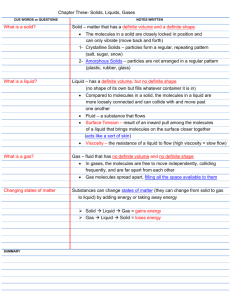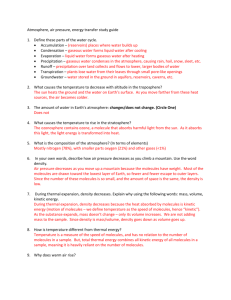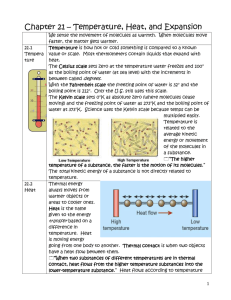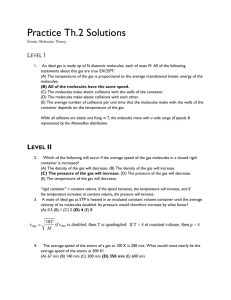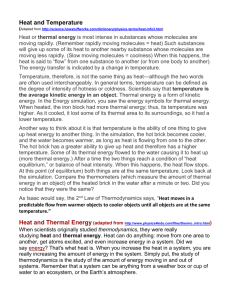Topic 3: Thermal Physics
advertisement
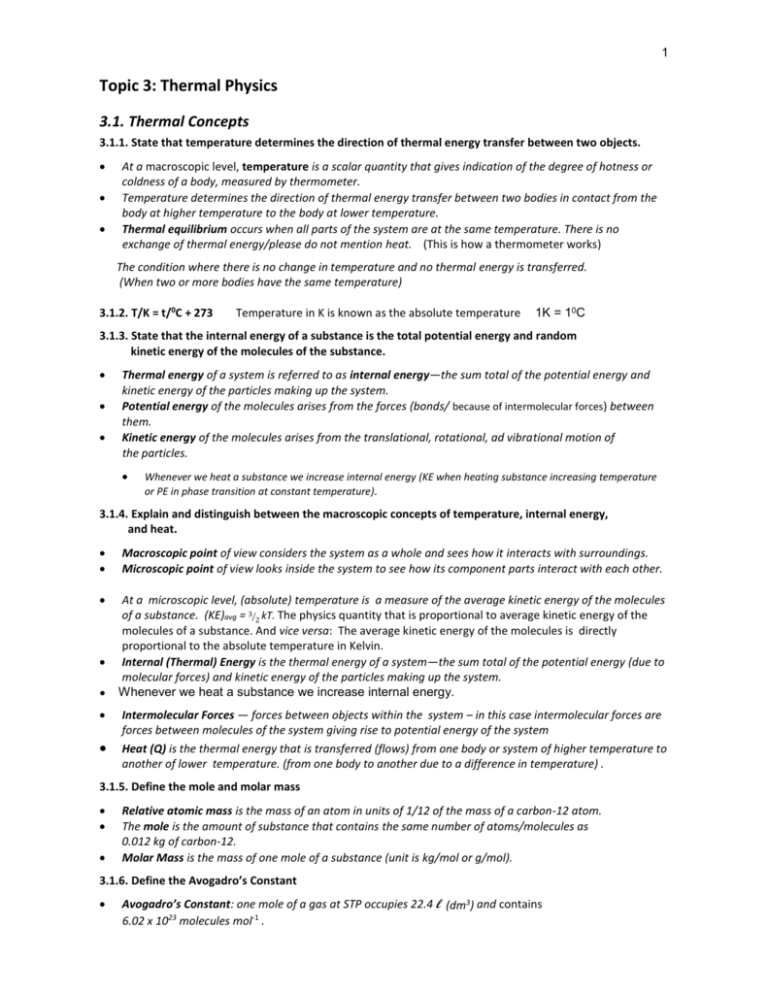
1 Topic 3: Thermal Physics 3.1. Thermal Concepts 3.1.1. State that temperature determines the direction of thermal energy transfer between two objects. At a macroscopic level, temperature is a scalar quantity that gives indication of the degree of hotness or coldness of a body, measured by thermometer. Temperature determines the direction of thermal energy transfer between two bodies in contact from the body at higher temperature to the body at lower temperature. Thermal equilibrium occurs when all parts of the system are at the same temperature. There is no exchange of thermal energy/please do not mention heat. (This is how a thermometer works) The condition where there is no change in temperature and no thermal energy is transferred. (When two or more bodies have the same temperature) 3.1.2. T/K = t/0C + 273 Temperature in K is known as the absolute temperature 1K = 10C 3.1.3. State that the internal energy of a substance is the total potential energy and random kinetic energy of the molecules of the substance. Thermal energy of a system is referred to as internal energy—the sum total of the potential energy and kinetic energy of the particles making up the system. Potential energy of the molecules arises from the forces (bonds/ because of intermolecular forces) between them. Kinetic energy of the molecules arises from the translational, rotational, ad vibrational motion of the particles. Whenever we heat a substance we increase internal energy (KE when heating substance increasing temperature or PE in phase transition at constant temperature). 3.1.4. Explain and distinguish between the macroscopic concepts of temperature, internal energy, and heat. Macroscopic point of view considers the system as a whole and sees how it interacts with surroundings. Microscopic point of view looks inside the system to see how its component parts interact with each other. At a microscopic level, (absolute) temperature is a measure of the average kinetic energy of the molecules of a substance. (KE)avg = 3⁄2 kT. The physics quantity that is proportional to average kinetic energy of the molecules of a substance. And vice versa: The average kinetic energy of the molecules is directly proportional to the absolute temperature in Kelvin. Internal (Thermal) Energy is the thermal energy of a system—the sum total of the potential energy (due to molecular forces) and kinetic energy of the particles making up the system. Whenever we heat a substance we increase internal energy. ● Intermolecular Forces — forces between objects within the system – in this case intermolecular forces are forces between molecules of the system giving rise to potential energy of the system Heat (Q) is the thermal energy that is transferred (flows) from one body or system of higher temperature to another of lower temperature. (from one body to another due to a difference in temperature) . 3.1.5. Define the mole and molar mass Relative atomic mass is the mass of an atom in units of 1/12 of the mass of a carbon-12 atom. The mole is the amount of substance that contains the same number of atoms/molecules as 0.012 kg of carbon-12. Molar Mass is the mass of one mole of a substance (unit is kg/mol or g/mol). 3.1.6. Define the Avogadro’s Constant Avogadro’s Constant: one mole of a gas at STP occupies 22.4 l (dm3) and contains 6.02 x 1023 molecules mol-1 . 2 3.2. Thermal Properties of Matter Specific Heat Capacities, Phase Changes, and Latent Heat 3.2.1. Define specific heat capacity and thermal capacity. Heat Capacity (also thermal capacity) is the amount of thermal energy needed to raise the temperature of an object by one degree Kelvin. C = 𝑄 ∆𝑇 → Q = C ΔT unit: (C) = J K-1 A body with a high heat capacity will warm up and cool down more because it needs more time to absorb/release a greater quantity of thermal energy Specific heat capacity is the quantity/amount of thermal energy required to raise the temperature of one kilogram of a substance by one degree Kelvin. c = ● 𝑄 𝑚∆𝑇 unit: (c) = J kg-1 K-1 homogeneous substance: C = mc To raise the temperature of a mass m by T degrees, the heat required is therefore Q = mc ΔT Whereas thermal capacity measures the substance’s ability to absorb heat as an entire object, specific heat capacity measures the substance’s ability to absorb heat per unit mass. 3.2.3. Explain the physical differences between the solid, liquid and gaseous phases in terms of molecular structure and particle motion. ♦ Phases (States) of Matter 4 phases: solid, liquid, gas and plasma; ordinary matter – only three phases Three phases of ordinary matter: Solid — State of matter with definite volume and definite shape ▪ characterized by high density and the molecules are held in fixed position by strong bonds. Molecules vibrate around a mean (equilibrium) position. ● Liquid — Materials that have definite volume but its shape can change – it takes the shape of their containers. ▪ density is lower and molecules are further apart without fixed positions. ▪ Molecules experience little resistance to motion and move freely about. There are still strong forces between the molecules but they are free to move around each other. ● Gas — Materials that have neither definite volume nor definite shape. ▪ gas will always expand to fit the container in which it is put. ▪ the forces between molecules are very weak – molecules are essentially independent of one another but they do occasionally collide. Ideal gas – no forces at all. ● 3 ♦ Phases (States) of Matter Characteristic Solid Liquid Gas Volume and shape definite volume and definite shape definite volume, shape can change – it takes the shape of their containers. neither definite volume nor definite shape expand to fit the container Compressibility Almost Incompressible Very Slightly Compressible Highly Compressible Bonds – intermolecular forces high density and the molecules are held in fixed position by strong bonds. density is lower and molecules are further apart without fixed positions the forces between molecules are very weak – molecules are essentially independent of one another but they do occasionally collide Comparative Density High High Low Vibrational, rotational, some translational Higher Mostly translational, higher rotational and vibrational Highest (ideal gas – zero) Kinetic Energy Vibrational Potential Energy Mean molecular Separation High r0 ( size of the particle) > r0 10 - 100 r0 3.2.4. Describe and explain the processes of phase changes in terms of molecular behavior. Phase transition is the transformation of a thermodynamic system from one phase to another. The distinguishing characteristic of a phase transition is an abrupt change in one or more physical properties, in particular the heat capacity, and the strength of intermolecular forces. Changes: While melting, vibrational kinetic energy increases and particles gain enough thermal energy to break from fixed positions. Potential energy of system increases. Melting point of a solid is the temperature (range) at which it changes state from solid to liquid. Once at the melting point, any additional heat supplied does not increase the temperature. Rather, this heat is used to overcome the forces between the solid molecules increasing potential energy. ◌ At the melting point the solid and liquid phase exist in equilibrium. While freezing, particles lose potential energy until thermal energy of the system is unable to support distance between particles and is overcome by the attraction force between them. Kinetic energy changes form from vibrational, rotational and part translational to merely vibrational. Potential energy decreases. While boiling, substance gains enough potential energy to break free from inter-particle forces. Similar to evaporation, the only difference being that energy is supplied from external source so there is no decrease in temperature. While condensing, the energy changes are opposite to that of boiling. 3.2.5. Explain in terms of molecular behavior why temperature does not change during a phase change. Phase transition — is the transformation of a thermodynamic system from one phase to another. ▪ During the process of phase transition temperature does not change, because all thermal energy 4 added or removed is used to change the total potential energy of the substance not kinetic. In the case of solid → liquid, solid to gas, and liquid to gas thermal energy transferred increases potential energy (potential energy becomes less negative – less attractive intermolecular forces) and vice versa. The distinguishing characteristic of a phase transition is an abrupt change in one or more physical properties, in particular the heat capacity, and the strength of intermolecular forces. During a phase change, the thermal energy gained/released will go towards increasing/decreasing the potential energy of the particles to either overcome or succumb to the intermolecular force that pulls particles together. In the process, the average kinetic energy will not change, so temperature will not change. Melting Point — of a solid is the temperature (range) at which it changes state from solid to liquid. ▪ Once at the melting point, any additional heat supplied does not increase the temperature. Rather, this heat is used to overcome the forces between the solid molecules increasing potential energy. ▪ At the melting point the solid and liquid phase exist in equilibrium. Freezing Point — the temperature at which the liquid changes state from a liquid to a solid. ▪ At the freezing point the solid and liquid phase exist in equilibrium. 3.2.6. Distinguish between evaporation and boiling. Evaporation is a change of phase from the liquid state to the gaseous state/vapour occuring at the surface of the liquid at the temperature below the boiling point. (Evaporation causes cooling) A liquid at a particular temperature has a range of particle energies , so at any instant, a small fraction of the particles will have KE considerably greater than the average value. If these particles are near the surface of the liquid, they will have enough KE to overcome the attractive forces of the neighbouring particles and escape from the liquid as a gas. The escape of the higher-energy particles will lower the average kinetic energy and thus lower the temperature. The rate of evaporation is the number of molecules escaping the liquid per second. Evaporation can be increased by • Increasing temperature/more particles have a higher KE • Increasing surface área/more particles closer to the surface • Increasing air flow above the surface/gives the particles somewhere to go to (decreasing the pressure of the air above liquid) The human body makes use of evaporative cooling by perspiration to give off energy even when surrounded by a temperature higher than body temperature. ● On average, the molecules do not have enough energy to escape from the liquid. When the molecules collide, they transfer energy to each other in varying degrees, based on how they collide. Sometimes the transfer is so one-sided that one of the molecules ends up with enough energy to be considered past the boiling point of the liquid. If this happens near the surface of the liquid it may actually fly off into the gas and thus "evaporate". Slower moving molecules are left behind meaning temperature of the liquid falls. ▪ The human body makes use of evaporative cooling by perspiration to give off energy even when surrounded by a temperature higher than body temperature. ▪ The rate of evaporation is the number of molecules escaping the liquid per second and increases as the surface area and temperature of the liquid are increased and pressure of the air above decreased. 5 3.2.7. Define Specific Latent Heat. Latent heat is the thermal energy that a substance/body absorbs or releases during a phase change at constant temperature. L = Qat const. temp. unit: J Specific latent heat of a substance is amount of therml energy required for 1 kg of a substance to undergo a phase change. Q L= → Q = mL unit: (L) = (J kg-1) m Fusion — change of phase from solid to liquid. Specific Latent Heat of Fusion (Lf ) — heat required to melt a unit mass of material at its melting point. ▪ To melt a quantity of mass m a quantity of heat Q = m Lf is required. Vaporization — change of phase from liquid to gas Specific Latent Heat of Vaporization (Lv) — heat required to vaporize a unit mass at its boiling point. ▪ To vaporize a quantity of mass m a quantity of heat Q = m Lv is required. Jerry check meaning of heat, please 3.2.8. Solve problems involving (specific) latent heat and (specific) heat capacity. 1. If the electrical energy is converted into increase of internal energy, then Qadded = IVt transferred to solid (in this case) hole in solid with electric probe in it = Qabosorbed The solid is going through all phases up to gas of temperature T 4 for example from T1 to T4 for the whole process: mass m from T1 to T4 IVt = m csolid (T2 – T1) + m Lfusion + m cliquid (T3 – T2) + m Lvaporazition + m cgas (T4 – T3) 2. mixing: a piece of cold solid of mass msolid1 at T1 thrown into hot liquid2 mliquid2 at T2. Assuming that solid would melt at temp Tm , and equilibrium temperature is T above T m, we have: Qreleased = Qabosorbed mliquid2 cliquid2 (T2 – T) = msolid1 csolid1 (Tm – T1) + msolid1 Lfusion + mliquid1 cliquid1 (T – Tm) Kinetic Model of an Ideal Gas msolid1 = mliquid1 help: PV = NkT 3.2.9. Define pressure. Air / gas pressure is the force gas molecules exert due to their collisions (with an object). 3.2.10. State the assumptions of the kinetic model of an ideal gas. Gases consist of tiny particles called atoms or molecules. The total number of molecules in any sample of a gas is extremely large. The molecules are in constant random motion. The range of the intermolecular forces is small compared to the average separation of the molecules. The size of the particles is relatively small compared with the distance between them. Collisions of short duration occur between molecules and the walls of the container and the collisions are perfectly elastic (no loss of kinetic energy). No forces act between particles except when they collide, and hence particles move in straight lines. Between collisions the molecules obey Newton’s Laws of motion. 3.2.11. State that the temperature is a measure of the average random kinetic energy of the molecules of an ideal gas. Temperature is a measure of the average random kinetic energy of the molecules of an ideal gas. 6 3.2.12. Explain the macroscopic behavior of an ideal gas in terms of a molecular model. Increase in temperature is equivalent of an increase in average kinetic energy (i.e. a greater average speed of particle movement). This leads to more collisions and collisions with greater impulse. Thus resulting in higher pressure. Decrease in volume results in a smaller space for gas particles to move, and thus a greater frequency of collisions. This results in an increase in pressure. Also, depending on the speed at which the volume decreases, particles colliding with the moving container wall may bounce back at greater speeds. This would lead to an increase in average kinetic energy and thus an increase in temperature. An increase in volume would have an opposite effect. KEavg = ( 12 mv 2 )avg = 3 2 kT k = Boltzmann constant Three Methods of Heat Transfer ▪ ▪ ▪ ▪ Thermal (Heat) Conduction — spontaneous transfer of thermal energy through matter, from a region of higher temperature to a region of lower temperature, that acts to equalize temperature differences. Gases transfer heat by direct collisions between molecules and their thermal conductivity is low compared to most solids since they are dilute media. Non-metallic solids transfer heat by lattice vibrations without any bulk movement of the substance (Lattice vibrations — molecules of a material vibrate more and more violently and collide with their neighbors, giving them energy. These, in turn, collide with their neighbors. The vibration is passed from one particle to the next so that eventually heat is transferred throughout the material even though no molecules have actually been transferred.) Metals are much better thermal conductors than non-metals because the same free electrons which participate in electrical conduction also take part in the transfer of heat. This mechanism of heat transfer is much stronger than lattice vibrations. Insulators — poor conductors Dominate mechanism in solids. Convection — heat transfer by mass motion (bulk movement) of a fluid (liquid and gas) such as air or water when the heated fluid is caused to move away from the source of heat, carrying energy with it. ▪ Heated part of fluid (above a hot surface ) expands, becomes less dense, and rises, causing convection currents which transport energy. ▪ Convection — heat is transferred through liquids and gases, cannot take place in solids. Radiation — is heat transfer by the emission of electromagnetic waves which carry energy away from the emitting object. ▪ all objects radiate electromagnetic waves that have a temperature above zero Kelvin ▪ For ordinary temperatures, the radiation is in the infrared region of the electromagnetic spectrum. ▪ Radiation — requires no medium for heat transfer (can travel through vacuum) ▪ Stefan-Boltzmann Law — the amount of energy per second radiated by a (black) body depends on its surface area, A, and absolute temperate, T. power P = A σT4 σ is the Stefan-Boltzmann constant. Kinetic Theory of Ideal Gas: consist of large numbers of molecules/atoms that behave like hard spheres in a state of constant, random motion. ▪ The molecules are much smaller than the distance between particles. Most of the volume of a gas is therefore empty space. ▪ Attractive and repulsive forces between gas molecules or between the particles and the walls of the container are negligible, so particles move in a straight line until they collide with another particle or the walls of the container. ▪ All energy is kinetic – no potential energy due to intermolecular forces ▪ Collisions between gas particles or collisions with the walls of the container are perfectly elastic (none of the energy of a gas particle is lost in collisions because there is no interaction between molecules or molecules and the wall.) 7 ▪ The average kinetic energy of a collection of gas particles depends on the temperature of the gas and nothing else. Energy can be transferred between molecules during collisions. KEavg ( 12 mv2 )avg 32 kT k = Boltzmann constant Pressure (P) — the normal force to an area per unit area (P = F/A). Unit: 1Pa (pascal) = 1N/1m2. Pressure in a gas (P) — results from the collisions of the gas molecules with the walls of its container and not from collisions between molecules. The two factors that affect the pressure of the gas are the average molecular speed and the frequency of collisions. Ideal Gas Law — The relationship between by three state variables that characterize an ideal gas: absolute pressure (P), volume (V), and absolute temperature (T). PV = nRT = NkT (deduced from kinetic theory) Pressure – Volume Law (Boyle — Marriott law) — at a constant temperature, the pressure of a gas is inversely proportional to its volume. PV = NkT = const. or P1V1 = P2V2 = const. at const. T and N Isotherms – lines of constant temperature T = constant means KEavg remains constant, and therefore average speed of the molecules, v, remains unchanged Volume increases → fewer collisions with the container walls over a given time → Therefore, the pressure will decrease Volume – Temperature Law (Charles's Law) — at constant pressure, volume increases uniformly with absolute temperature (in Kelvins). PV = NkT = const. if N and P are constant, then V V V Nk constant , so V constant T or 1 2 T P T1 T2 Isobars – lines of constant pressure – intercept at absolute zero – impossible to achieve, volume would be zero – hence dashed lines T increases means KEavg increases, thus average speed v increases → more collisions per unit time and molecules strike the wall harder (momentum increased) → increase in pressure ● If we allow the volume to change to maintain constant pressure, the volume will increase with increasing temperature 8 Pressure – Temperature Law (Gay- Lussac Law) — at a constant volume the pressure of a gas is proportional to its temperature in Kelvins. PV = NkT = const. if N and V are constant, then P P P Nk constant , so P constant T or 1 2 T V T1 T2 Isochors – lines of constant volume (isovolumetric lines) – intercept at absolute zero – impossible to achieve, pressure would be zero (still world) – hence dashed lines T increases means KEavg increases, thus average speed v increases → more collisions per unit time and molecules strike the wall harder (momentum increased) → increase in pressure ● If we do not allow the volume to change, the pressure will increase with increasing temperature
